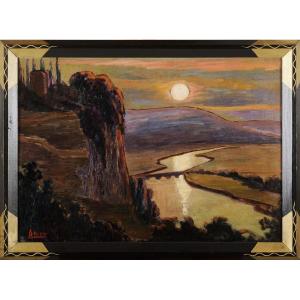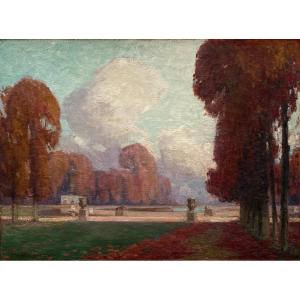(Périgueux 1851 - 1936)
The banks of the Dordogne
Oil on canvas
H. 100 cm; L. 73 cm
Signed and dated 1903 lower right. Located on the back.
Provenance: Private collection, Périgueux
Jean-Georges Pasquet was born in 1851, in Périgueux. After a very little documented Périgord childhood, the young artist arrived in Paris and joined the School of Fine Arts, from which he graduated a few years later. He returned to his land in 1879 to take over the management of the municipal drawing school of Périgueux, and also became a drawing teacher at the Normal Schools for boys and girls. Pupil of Gustave Boulanger, Jules Lefèvre and Jean-Joseph Benjamin-Constant, the painter puts his easel on the banks of the Dordogne or the Isle to "tell some memories" through realistic landscapes filled with softness. Through his style, the painter reveals a great idea to his compatriots, of his country and his origins. We find works devoid of artifice, representing the inhabitants of the region, working their land or simply strolling on paths. These paintings or drawings by Pasquet retrace the life of Périgord at dawn and during the 20th century, always located in very specific places. He is one of the artists of the School of Périgueux. This school, somewhat forgotten in the history of art, highlights the heritage and identity of the Perigord lands. Among the representatives, we find Jean-Louis Daniel, André Saigne, Georges Darnet, René Laforest, Roger Favard and André Prugent. This movement has as a common denominator a theme that stands out from the canons of the time: the landscape. “It's a school without a leader and without a dominant style, but which worked with extraordinary enthusiasm. They liked to attack pieces of nature that we call here picadis. Jean-Michel Linfort
In the same house since the middle of the 20th century, this large luminous canvas was placed in a dining room to which it offered an additional window. The banks of the Dordogne did not often offer their landscapes to the brushes and easel of Pasquet, who concentrated on the outskirts of Périgueux. In 1903, he produced this work with a very classic framing and composition but giving the Perigord landscape great strength through its atmosphere.






































 Le Magazine de PROANTIC
Le Magazine de PROANTIC TRÉSORS Magazine
TRÉSORS Magazine Rivista Artiquariato
Rivista Artiquariato